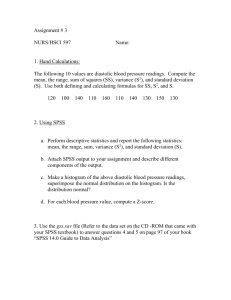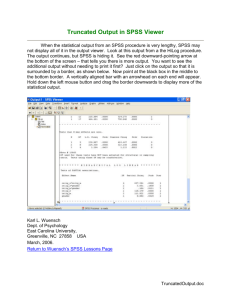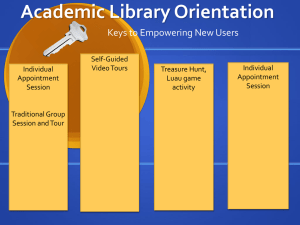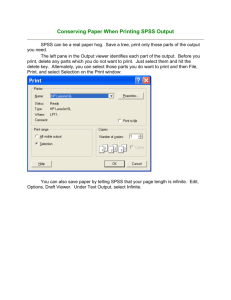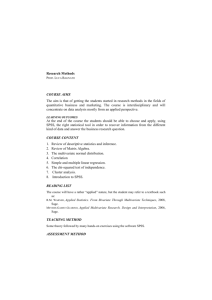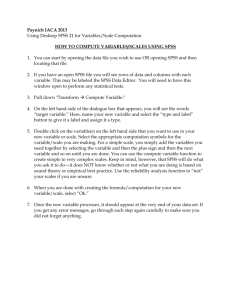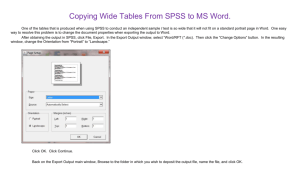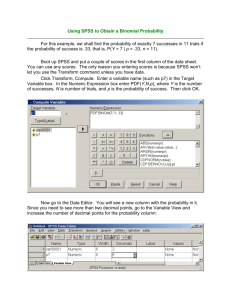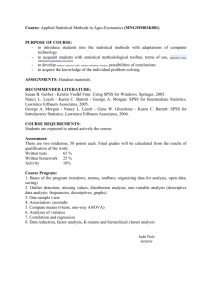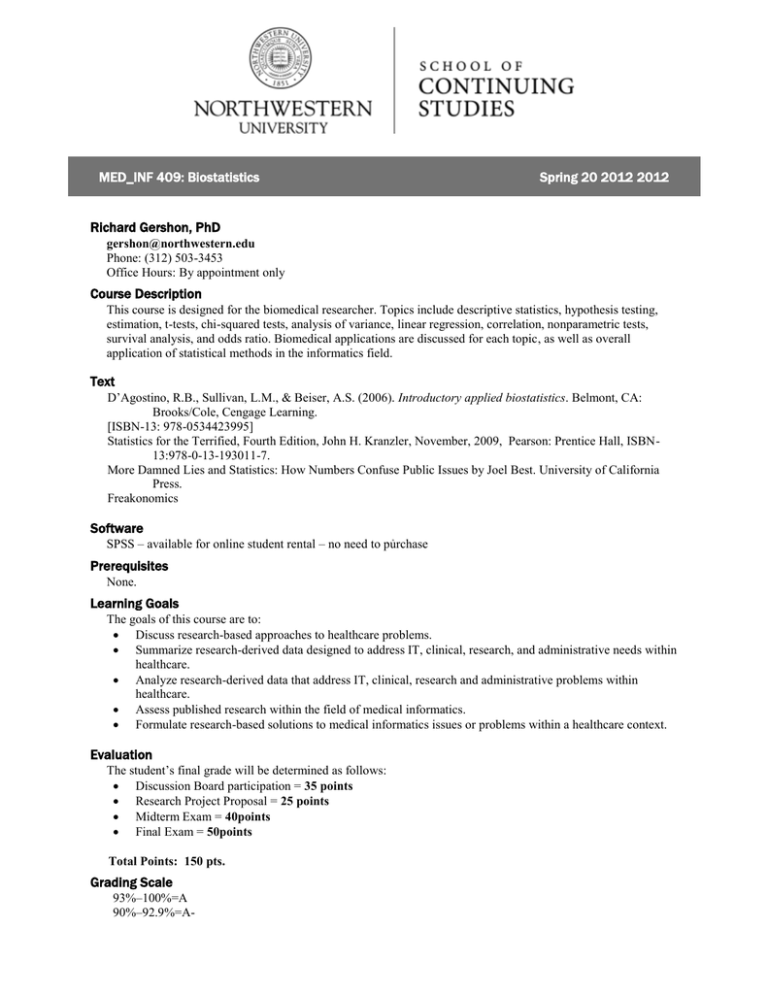
MED_INF 409: Biostatistics
Spring 20 2012 2012
Richard Gershon, PhD
gershon@northwestern.edu
Phone: (312) 503-3453
Office Hours: By appointment only
Course Description
This course is designed for the biomedical researcher. Topics include descriptive statistics, hypothesis testing,
estimation, t-tests, chi-squared tests, analysis of variance, linear regression, correlation, nonparametric tests,
survival analysis, and odds ratio. Biomedical applications are discussed for each topic, as well as overall
application of statistical methods in the informatics field.
Text
D’Agostino, R.B., Sullivan, L.M., & Beiser, A.S. (2006). Introductory applied biostatistics. Belmont, CA:
Brooks/Cole, Cengage Learning.
[ISBN-13: 978-0534423995]
Statistics for the Terrified, Fourth Edition, John H. Kranzler, November, 2009, Pearson: Prentice Hall, ISBN13:978-0-13-193011-7.
More Damned Lies and Statistics: How Numbers Confuse Public Issues by Joel Best. University of California
Press.
Freakonomics
Software
SPSS – available for online student rental – no need to pủrchase
Prerequisites
None.
Learning Goals
The goals of this course are to:
Discuss research-based approaches to healthcare problems.
Summarize research-derived data designed to address IT, clinical, research, and administrative needs within
healthcare.
Analyze research-derived data that address IT, clinical, research and administrative problems within
healthcare.
Assess published research within the field of medical informatics.
Formulate research-based solutions to medical informatics issues or problems within a healthcare context.
Evaluation
The student’s final grade will be determined as follows:
Discussion Board participation = 35 points
Research Project Proposal = 25 points
Midterm Exam = 40points
Final Exam = 50points
Total Points: 150 pts.
Grading Scale
93%–100%=A
90%–92.9%=A-
MED_INF 409: Biostatistics
Winter 2012
87%–89.9%=B+
83%–86.9%=B
80%–82.9%=B77%–79.9%=C+
73%–76.9%=C
70%–72.9%=CBelow 70%=F
Discussion Board Etiquette
The purpose of the discussion boards is to allow students to freely exchange ideas. It is imperative to remain
respectful of all viewpoints and positions and, when necessary, agree to respectfully disagree. While active and
frequent participation is encouraged, cluttering a discussion board with inappropriate, irrelevant, or insignificant
material will not earn additional points and may result in receiving less than full credit. Frequency is not
unimportant, but content of the message is paramount. Please remember to cite all sources—when relevant—in
order to avoid plagiarism.
All students are required to read, and respond where appropriate, on a regular basis to the material on the
Discussion board. During the first sync session we will review requirements for posting content (if the class size
is large, then posting requirements may be reduced).
Proctored Assessment
There is a proctored assessment requirement in this course. For additional information, please go to the
Assignments section in Blackboard and scroll to the Proctored Exam Approval Application item.
Attendance
This course will not meet at a particular time each week. All course goals, session learning objectives, and
assessments are supported through classroom elements that can be accessed at any time. To measure class
participation (or attendance), your participation in threaded discussion boards is required, graded, and paramount
to your success in this class. Please note that any scheduled synchronous or “live” meetings are considered
supplemental and optional. While your attendance is highly encouraged, it is not required and you will not be
graded on your attendance or participation.
Late Work
Work submitted late will have 10 points deducted for each day it is late. Assignments will not be accepted after
two days and the student will receive zero points for the assignment.
Learning Groups
Learning groups are utilized in this course. More information about learning groups will be provided by the
instructors via the Blackboard course site.
Academic Integrity at Northwestern
Students are required to comply with University regulations regarding academic integrity. If you are in doubt
about what constitutes academic dishonesty, speak with your instructor or graduate coordinator before the
assignment is due and/or examine the University Web site. Academic dishonesty includes, but is not limited to,
cheating on an exam, obtaining an unfair advantage, and plagiarism (e.g., using material from readings without
citing or copying another student's paper). Failure to maintain academic integrity will result in a grade sanction,
possibly as severe as failing and being required to retake the course, and could lead to a suspension or expulsion
from the program. Further penalties may apply. For more information,
visit<www.scs.northwestern.edu/student/issues/academic_integrity.cfm>.
Plagiarism is one form of academic dishonesty. Students can familiarize themselves with the definition and
examples of plagiarism, by visiting <www.northwestern.edu/uacc/plagiar.html>. A myriad of other sources can
be found online.
Some assignments in this course may be required to be submitted through SafeAssign, a plagiarism detection and
education tool. You can find an explanation of the tool at
<http://wiki.safeassign.com/display/SAFE/How+Does+SafeAssign+Work>. In brief, SafeAssign compares the
submitted assignment to millions of documents in large databases. It then generates a report showing the extent
to which text within a paper is similar to pre-existing sources. The user can see how or whether the flagged text is
appropriately cited. SafeAssignalso returns a percentage score, indicating the percentage of the submitted paper
that is similar or identical to pre-existing sources. High scores are not necessarily bad, nor do they necessarily
© 2012 Northwestern University School of Continuing Studies
2
MED_INF 409: Biostatistics
Winter 2012
indicate plagiarism, since the score does not take into account how or whether material is cited. If a paper
consisted of one long quote that was cited appropriately, it would score 100%. This wouldnot be plagiarism, due
to the appropriate citation. However, submitting one long quote would probably be a poor paper.Low scores are
not necessarily good, nor do they necessarily indicate a lack of plagiarism. If a 50-page paper contained all
original material, except for one short quote that was not cited, it might score around 1%. But, not citing a
quotation is still plagiarism.
SafeAssign includes an option in which the student can submit a paper and see the resultant report before
submitting a final copy to the instructor. This ideally will help students better understand and avoid plagiarism.
Other Processes and Policies
Please refer to your SCS student handbook at<www.scs.northwestern.edu/grad/information/handbook.cfm>for
additional course and program processes and policies.
© 2012 Northwestern University School of Continuing Studies
3
MED_INF 409: Biostatistics
Winter 2012
Course Schedule
Important Note: Changes may occur to the syllabus at the instructor's discretion.
When changes are made, students will be notified via an announcement in Blackboard.
Session 1
Learning Objectives
After this session, the student will be able to:
Explain use of statistics in medical informatics.
Identify fundamental steps in conducting research.
Identify types of variables.
Recognize levels of measurement.
Distinguish between population and sample.
Distinguish between parameter and statistic.
Distinguish between various methods of sampling.
Open a data file in SPSS to conduct basic operations.
Course Content
Textbook Reading
D’Agostino, Chapters 1 – 2
Online Reading
Review NIH website (www.nih.gov) for medical informatics and medical research
Research Fundamentals: Statistical Considerations in Research Design: A Simple Person’s Approach
Handout #1 – Levels of measurement
Self-Guided Practice
SPSS software basic package, current version
Review SPSS Tutorial in software:
Help->tutorial->Introduction
Helpful sections include: opening a data file, running an analysis, and viewing results. …tutorial>reading data -> reading data from SPSS files, reading data from Excel spreadsheets
Print and Video SPSS Tutorials on Web: http://calcnet.mth.cmich.edu/org/spss/toc.htm
Sample data file: pain_medication.sav
Self-guided practice (not turned in); compare with self-guided practice answer key.
Files:
Pain_medication.sav
Pain_medication questions.doc
Solutions to Questions for Pain medication.doc
Discussion Board
Each session you are required to participate in the session-specific discussion board forum. Your participation in
both posting and responding to other students' comments is graded. For this session’s discussion topic(s), visit
the discussion board in Blackboard.
Assignments
None.
Sync Session
March 26 - First Sync Session 7-9pm CENTRAL
© 2012 Northwestern University School of Continuing Studies
4
MED_INF 409: Biostatistics
Winter 2012
Session 2
Learning Objectives
After this session, the student will be able to:
Distinguish between qualitative and quantitative variables.
Distinguish between nominal, ordinal, interval, and ratio data use in SPSS.
Distinguish between symmetrical, bimodal, and skewed distributions.
Distinguish between positively and negatively skewed distributions.
Define key terms in descriptive statistics.
Identify outliers in a data set.
Distinguish which form of data presentation is appropriate for different situations.
Summarize data using appropriate forms of data presentation.
Interpret descriptive statistics given SPSS output for a study.
Course Content
Textbook Reading
D’Agostino, Chapter 2
Online Reading
Handout #1 – levels of measurement
Multimedia
Descriptive Statistics
Self-Guided Practice
SPSS software basic package, current version
Review SPSS tutorial:
Help->tutorial examining summary statistics for individual variables.
Print and Video SPSS Tutorials on web: http://calcnet.mth.cmich.edu/org/spss/toc.htm
Self-guided practice (not turned in); compare with self-guided practice answer key
Discussion Board
Each session you are required to participate in the session-specific discussion board forum. Your participation in
both posting and responding to other students’ comments is graded. For this session’s discussion topic(s), visit
the discussion board in Blackboard.
Assignments
None.
Sync Session
April 2 - Optional Open Office Session 8pm Central
© 2012 Northwestern University School of Continuing Studies
5
MED_INF 409: Biostatistics
Winter 2012
Session 3
Learning Objectives
After this session, the student will be able to:
Define deterministic and random experiments.
Define probability and its basic properties.
Explain the probability distribution.
Apply the rule of addition for probabilities for mutually exclusive events.
Apply the rule of multiplication of probabilities for independent events.
Calculate the probability of an event and its complement.
State the properties of a binomial distribution.
Compute probabilities using normal and binomial distributions.
Interpret probabilities using normal and binomial distributions.
Describe the relationship between the central limit theorem and the normal probability distribution.
Differentiate between the normal distribution and the standard normal curve.
Explain the Z score.
Calculate the Z score given a value from a normal probability distribution (NPD) with a specified mean and
standard deviation.
Use the Z score table to determine the probability associated with any Z score.
Course Content
Textbook Reading
D’Agostino, Chapters 3 - 5
Multimedia
Probability
Binomial Distribution
Central Limit Theorem
Normal Probability Distribution
Self-Guided Practice
Self-guided practice (not turned in); compare with self-guided practice answer key
Discussion Board
Each session you are required to participate in the session-specific discussion board forum. Your participation in
both posting and responding to other students’ comments is graded. For this session’s discussion topic(s), visit
the discussion board in Blackboard.
Assignments
None.
Sync Session
None.
© 2012 Northwestern University School of Continuing Studies
6
MED_INF 409: Biostatistics
Winter 2012
Session 4
Learning Objectives
After this session, the student will be able to:
Explain the difference between parent distributions and sampling distributions.
Describe the use of the central limit theorem to determine the properties of the probability distribution for a
sampling distribution.
Describe standard error of the mean and its relation to sample size.
Compute the standard error of the mean.
Interpret the standard error of the mean.
Compute the confidence interval for a sample mean.
Describe when the t-distribution should be used.
Define the assumptions for one-sample procedures.
Compute one-sample procedures.
Interpret results obtained from one-sample procedures.
State the null and alternative hypotheses for a general research hypothesis.
Describe the five steps of hypothesis testing.
Use the five steps of hypothesis testing for a one-sample test of a sample mean.
Discuss use of one-sample procedures within medical informatics literature.
Course Content
Textbook Reading
D’Agostino, Chapters 4 - 5
Online Reading
Confidence Intervals
Self-Guided Practice
Self-guided practice (not turned in); compare with self-guided practice answer key
Discussion Board
Each session you are required to participate in the session-specific discussion board forum. Your participation in
both posting and responding to other students’ comments is graded. For this session’s discussion topic(s), visit
the discussion board in Blackboard.
Assignments
The Practice Midterm is available for review.
Sync Session
April 2 - Optional Open Office Session 8pm Central
© 2012 Northwestern University School of Continuing Studies
7
MED_INF 409: Biostatistics
Winter 2012
Session 5
Learning Objectives
After this session, the student will be able to:
Define the t-test for an independent sample.
Define the t-test for a dependent sample.
State the assumptions for use of t-tests to analyze data.
Describe the t-distribution.
State the hypothesis for t-tests.
Define type 1 and type 2 errors.
Define power.
Compute t.
Determine the sample size needed for a two-sample procedure.
Use the five steps of hypothesis testing for two sample tests of sample means.
Discuss use of two-sample procedures within medical informatics literature.
Course Content
Textbook Reading
D’Agostino, Chapter 6
Self-Guided Practice
Self-guided practice (not turned in); compare with self-guided practice answer key
Review SPSS Tutorial in software
Print and Video SPSS Tutorials on web: http://calcnet.mth.cmich.edu/org/spss/toc.htm
Discussion Board
Each session you are required to participate in the session-specific discussion board forum. Your participation in
both posting and responding to other students’ comments is graded. For this session’s discussion topic(s), visit
the discussion board in Blackboard.
Assignments
For more information, click Assignments on the left navigation bar in Blackboard, and scroll to this assignment’s
item.
Sync Session
April 23 - Second Sync Session 7-9 pm. Take-home” Midterm Available April 24 due by
Midnight, April 29
© 2012 Northwestern University School of Continuing Studies
8
MED_INF 409: Biostatistics
Winter 2012
Session 6
Learning Objectives
After this session, the student will be able to:
Differentiate between independent and dependent variables.
Define ANOVA terminology.
Describe the F distribution.
Define the assumptions for ANOVA.
Interpret ANOVA tables.
Apply multiple comparison procedures in ANOVA.
Use the five steps of hypothesis testing for ANOVA.
Discuss use of ANOVA within medical informatics literature.
Course Content
Textbook Reading
D’Agostino, Chapter 9
Self-Guided Practice
Self-guided practice (not turned in); compare with self-guided practice answer key
Review SPSS Tutorial in software
Print and Video SPSS Tutorials on web: http://calcnet.mth.cmich.edu/org/spss/toc.htm
Discussion Board
Each session you are required to participate in the session-specific discussion board forum. Your participation in
both posting and responding to other students’ comments is graded. For this session’s discussion topic(s), visit
the discussion board in Blackboard.
Assignments
None.
Sync Session
April 30 - Optional Open Office Session 8pm
© 2012 Northwestern University School of Continuing Studies
9
MED_INF 409: Biostatistics
Winter 2012
Session 7
Learning Objectives
After this session, the student will be able to:
Describe the chi-square distribution.
Describe appropriate uses of the chi-square test.
Define the assumptions for chi-square.
Compute observed and expected values for a chi-square contingency table.
Use the five steps of hypothesis testing for chi-square.
Discuss use of chi-square within medical informatics literature.
Course Content
Textbook Reading
D’Agostino, Chapter 7
Online Reading
Handout: Calculating Chi-square and Expected Frequencies
Self-Guided Practice
Self-guided practice (not turned in); compare with self-guided practice answer key
Review SPSS Tutorial in software
Print and Video SPSS Tutorials on web: http://calcnet.mth.cmich.edu/org/spss/toc.htm
Discussion Board
Each session you are required to participate in the session-specific discussion board forum. Your participation in
both posting and responding to other students’ comments is graded. For this session’s discussion topic(s), visit
the discussion board in Blackboard.
Assignments
None.
Sync Session
None.
© 2012 Northwestern University School of Continuing Studies
10
MED_INF 409: Biostatistics
Winter 2012
Session 8
Learning Objectives
After this session, the student will be able to:
Define key terms in correlation and regression.
Describe independent (X) and dependent (Y) variables in correlation and regression.
Define the assumptions for correlation and regression.
Recognize linear and other models of regression.
Compute r, r2 and linear regression components.
Interpret the nature and strength of association between two variables using a scattergram, r and r2.
Interpret linear regression components.
Use a regression equation to predict Y.
Use the five steps of hypothesis testing for correlation and regression.
Discuss use of correlation and linear regression within medical informatics literature.
Course Content
Textbook Reading
D’Agostino, Chapter 10
Multimedia
Linear Regression
Self-Guided Practice
Self-guided practice (not turned in); compare with self-guided practice answer key
Review SPSS Tutorial in software
Print and Video SPSS Tutorials on web: http://calcnet.mth.cmich.edu/org/spss/toc.htm
Discussion Board
Each session you are required to participate in the session-specific discussion board forum. Your participation in
both posting and responding to other students’ comments is graded. For this session’s discussion topic(s), visit
the discussion board in Blackboard.
Assignments
None.
Sync Session
May 14 - Optional Open Office Session 8pm Central
© 2012 Northwestern University School of Continuing Studies
11
MED_INF 409: Biostatistics
Winter 2012
Session 9
Learning Objectives
After this session, the student will be able to:
Differentiate between parametric and nonparametric tests.
Define the assumptions for various nonparametric tests.
Identify the nonparametric test that would be used if the assumptions for the corresponding parametric test
were not met.
Use the five steps of hypothesis testing for nonparametric tests.
Discuss use of nonparametric tests within medical informatics literature.
Propose a research-based solution to a medical informatics problem within a healthcare context.
Course Content
Textbook Reading
D’Agostino, Chapter 12
Online Reading
Handout: Nonparametric vs. Parametric Tests
Self-Guided Practice
Self-guided practice (not turned in); compare with self-guided practice answer key
Review SPSS Tutorial in software
Print and Video SPSS Tutorials on web: http://calcnet.mth.cmich.edu/org/spss/toc.ht
Discussion Board
Each session you are required to participate in the session-specific discussion board forum. Your participation in
both posting and responding to other students’ comments is graded. For this session’s discussion topic(s), visit
the discussion board in Blackboard.
Assignments
). For more information, click Assignments on the left navigation panel in Blackboard, and scroll to this
assignment’s item.
The Practice Final Exam is available for review.
Sync Session
May 21 - Final Regular Sync Session 7-9pm
© 2012 Northwestern University School of Continuing Studies
12
MED_INF 409: Biostatistics
Winter 2012
Session 10
Learning Objectives
After this session, the student will be able to:
No new learning objectives will be introduced in this Session.
Course Content
None.
Discussion Board
Each session you are required to participate in the session-specific discussion board forum. Your participation in
both posting and responding to other students’ comments is graded. For this session’s discussion topic(s), visit
the discussion board in Blackboard.
Assignments
The Final Exam is due is Session 10. For more information, click Assignments on the left navigation bar in
Blackboard, and scroll to this assignment’s item.
Sync Session
None.
© 2012 Northwestern University School of Continuing Studies
13

